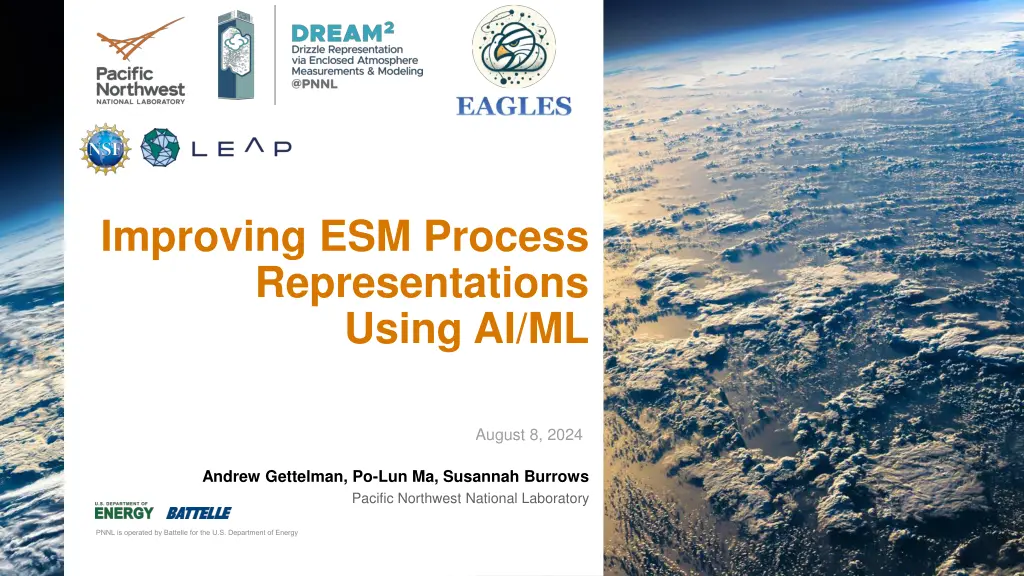
Improving ESM Process Representations Using AI/ML in Climate Science
Explore how AI/ML approaches are enhancing Earth System Model (ESM) process representations in climate science, with examples like machine learning the warm rain process and aerosol parameterizations. Discover the exciting opportunities, challenges, and gaps in utilizing AI/ML to advance climate modeling.
Download Presentation

Please find below an Image/Link to download the presentation.
The content on the website is provided AS IS for your information and personal use only. It may not be sold, licensed, or shared on other websites without obtaining consent from the author. If you encounter any issues during the download, it is possible that the publisher has removed the file from their server.
You are allowed to download the files provided on this website for personal or commercial use, subject to the condition that they are used lawfully. All files are the property of their respective owners.
The content on the website is provided AS IS for your information and personal use only. It may not be sold, licensed, or shared on other websites without obtaining consent from the author.
E N D
Presentation Transcript
Improving ESM Process Representations Using AI/ML August 8, 2024 Andrew Gettelman, Po-Lun Ma, Susannah Burrows Pacific Northwest National Laboratory
Summary and Outline AI/ML approaches are percolating into parameterizations Here, some E3SM Examples Theme: Off-Line Training, Emulation of Complex Codes Outline: 1. A better treatment of rain formation 2. Learning Aerosol Optics and Aerosol Activation 3. A broader view of AI/ML challenges and opportunities 2
Machine Learning the Warm Rain Process Initial CESM results Emulator reproduces Bin code Can we do the warm rain process better with ML? Replace traditional GCM bulk rain formation with a bin model formulation for stochastic collection. This is too expensive for climate use. Emulate it with a neural network. Results: Bin code can improve rain formation results Recover speed and results with neural network emulator Embedded NN in the microphysics: maintains conservation with series of checks Implemented first in CESM, now ported to E3SM (not in master) TAU Bin BIN code closer to Observations than Control Gettelman et al 2021, JAMES
Emulator Running Interactively in E3SM Bulk Rain Formation Bin Rain Formation Emulated Rain Formation TAU and updated emulator (single NN) are running interactively in E3SM. Emulator (from CESM) looks different than bin code in E3SM it is trying to emulate 4
Machine Learning Aerosol Parameterizations RIGHT: Machine Learning aerosol activation reproduces existing scheme when regularized (Silva, Ma et al 2021, GMD) Left: Machine Learning aerosol optics better reproduces detailed Mie calculations than current parameterizations (Geiss, Ma et al 2023, GMD) NN Range 5
Strategery: Paths Forward with AI/ML Opportunities, Challenges, Gaps Opportunity: AI Can simplify the model hierarchy for domain science Train parameterizations off detailed models to use across scales Use LLMs (ChatGPT, etc.) to do code translation between languages Python C++ Fortran (JAX and Julia also options) Opportunity: Exploring Foundation Modeling (mixed modeling) with AI/ML Need to partner with Industry (Google, Microsoft, NVIDIA): develop coherent relationships NeuralGCM type differential approaches (learning physics or components) Foundation emulators: GraphCast, FourCastNet, etc: learning the whole model solutions DOE offers expertise, computation, training data, interoperability. Industry: AI expertise, computation Foundation models may replace core parts of models (dycore, thermodynamic state) Develop further models (aerosols, climate extremes, energy grid) from foundation models Will ML eat the model ? (now learning the solution still relies on the IFS/Reanalysis) Gap: AI and Observations: Simulators and Assimilation approaches Very relevant for ARM data: to better compare to models, and to help with data processing Challenge/Gap: Robustness, Uncertainty, Interpretability (DOE can lead) 6
